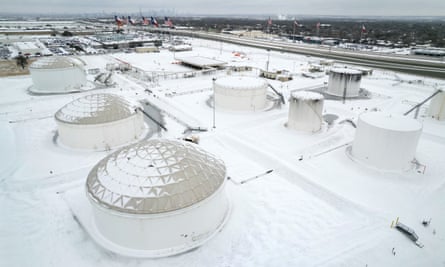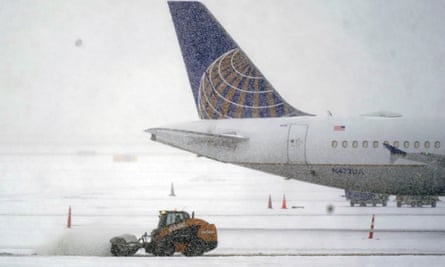As many Texans endure another harsh cold snap this week when a winter storm hits the state, some 50,000 people have been hit by power outages in a grim reminder of last year’s big freeze in the state.
While this week’s experience will probably not rival the 2021 winter storm that left much of Texas in darkness and was responsible for several hundred deaths, it is a test for the state’s capacity to handle the challenges of more severe weather as a result of the ongoing global climate crisis.
Governor Greg Abbott has already caught flak for backtracking on the promise he made just two months ago that power outages would not occur this winter.
This week, as power began to fail in some Texas homes, it prompted condemnation from prominent local politicians that not enough had been done over the last year to protect Texans’ access to power.
Former presidential candidate Julián Castro told the Guardian: “Greg Abbott and Texas Republicans sold our state’s power grid to the highest bidder, and as a result, five million families lost power and hundreds lost their lives. Rather than working to fix the grid, they let energy lobbyists write their own laws and collected millions in political donations in return. We need new leadership that will work to modernize our grid and prioritize sustainability, not more corrupt politicians who line their pockets with money from special interests.”
Texas is working around the clock to respond to the winter storm expected to impact our state over the next few days.
— Greg Abbott (@GregAbbott_TX) February 1, 2022
State agencies are working together to provide resources & information to keep Texans safe.
In a statement to the Guardian, the Electric Reliability Council of Texas (Ercot), which operates the state’s electrical grid said it was taking early action to try to head off any outages: “Ercot will deploy all the tools available to us to manage the grid effectively during this winter weather.”
But such statements might not alleviate all fears in a state where the impact of winter storm Uri – which saw at least 246 deaths – is still keenly remembered. At that time, the grid that powered nearly the entire state began to fail, forcing energy regulators to roll out blackouts in order to avoid a complete shutdown. In the end some 4 million households were left without power in freezing temperatures for days.
Here is a look at the problems, how they have been tackled and what needs to still happen:
Bureaucratic failure and improvements
As far as seeing a repeat on the scale of last year’s disaster, experts predict Texas is better prepared now as some upgrades to the infrastructure powering the state have either been made or are under way.
But there is also still much to be done, according to Kenneth Medlock, an energy economist and fellow at Rice University’s Baker Institute for Public Policy. He called the state’s capacity to handle last year’s winter storm “a failure on all fronts”.
“[The power supply chain] actually got cut off during the winter storm last year which contributed to the downward spiral in the state. You had capacity outages experienced by virtually every form of generation,” said Medlock.
In addition to being structurally unprepared for the extremely cold weather, the lack of communication between the the Public Utility Commission (PUC) and the Texas railroad commission, the state agencies overseeing power and oil and gas, respectively, proved to be both inefficient and dangerous.

Hospitals, for example, never had their power cut because they were automatically deemed “critical infrastructure”, but other entities in dire need of constant power, like waste management and water treatment plants, needed to apply for the designation. The power blackouts at water treatment facilities forced nearly every major city in the state to issue a “boil water” notice before consumption.
In order to be designated as critical infrastructure, power suppliers needed to fill out a form found on Ercot’s website. However, the form was not publicized and therefore not completed, meaning those who most needed power, went without when forced outages began to roll out.
“It’s literally a two-page form. As long as you fill it out, being deemed critical means electricity can be directed to a specific consumer,” said Medlock. “The biggest failure that we saw last year was bureaucratic.”
As a result of this bureaucratic failure, the PUC also unintentionally turned off the lights at natural gas facilities, which deliver power to much of the state.
As of today, most gas supply infrastructure in the state has been designated as critical, which prioritizes their power supply in the event power outages are ever required again.
“This by itself adds a lot of capacity back into the mix that we didn’t have last winter. Even if there’s no additional winterization requirements fulfilled, that’s going to bring anywhere from 7 or 9 gigawatts of capacity back to the grid,” said Medlock.
Early warnings and weatherization
In June 2021, the summer following the winter storm, the state passed Senate Bill 3, a new law “relating to preparing for, preventing, and responding to weather emergencies, power outages, and other disasters …”

One provision of the new law mandates the creation of an emergency alert system that will notify residents of upcoming power outages via text rather than cutting off power without notice and literally leaving millions of Texans in the dark.
More importantly, the law now requires power plants to “weatherize” or update their equipment to withstand extreme weather to prevent outages in the first place.
However, these weatherization regulations do not apply to oil and gas production and distribution facilities like wellheads and pipelines, which serve as the fuel supply chain to the power plants.
“[The legislation] didn’t go far enough,” said Cyrus Reed, the conservation director of the Lone Star chapter of the Sierra Club, a US based environmental organization. “The gas supply has not been required to winterize yet. Even in these recent freezes [in January 2022], we’ve had some problems. We did have some power plants in the Permian Basin that couldn’t operate because they couldn’t get the gas supply, so it did impact power production.”
Energy market changes, higher bills
Unlike some other states that have designated utility providers, the energy market in Texas is open. This means customers can select any electricity provider within their supply area. Most electricity providers offer fixed-rate contracts for a limited period of time. If the contract expires, customers are charged a variable rate at their provider’s discretion.
In February 2021, that rate was astronomical because demand was so high and the providers from which Texas companies bought power could charge whatever they wanted, engaging in price gouging practices that left some Texans whose power stayed on with electricity bills for thousands of dollars for the week of the winter storm.

Now, regulators have made it so wholesale electricity customers will not have bills quite so high, but they stopped short of regulating electricity prices.
Still, energy customers – nearly every Texas resident and business – will see their bill increase significantly with energy providers citing the necessary infrastructure updates as the culprit for the higher prices.
In San Antonio, the city’s public energy provider, CPS Energy, increased their base rate by 3.85%, saying “the pass-through fee will help CPS Energy recover $418m it has already paid in fuel costs from the winter storm in February 2021”. Customers of private energy providers like CenterPoint, NRG, or TXU, for example, could see even higher bill increases.
Plans to use state funds to subsidize necessary and expensive upgrades to power plants did not advance. Instead, customers are left footing the bill.
“It’s corporate welfare, basically,” Reed said.
Reed believes the state could do more to protect customers, or rather average Texans, by also addressing the high demand due to energy-inefficient building codes.
“We didn’t have enough [power] supply, but you could look at it the other way. The other thing you could say is that we had too much demand,” Reed said. “Either the gas didn’t get to the power plants or the wind turbines froze. We have all these old buildings and old homes, some of which are using resistance strip heating (electric heaters) … Unlike other states, we as a state haven’t put a lot of investment and goals and programs into energy efficiency and demand response.”

Texas’s climate future
Could Texas see another winter storm of that scale? According to the Texas state climatologist, John Nielsen-Gammon, another severe “Arctic blast” hitting the state, like the one seen in 2021, is not so likely, though not impossible.
“[A big freeze is] less likely for two reasons: Arctic temperatures are warming faster than the rest of the planet. As the weather patterns that lead to cold air become more common, the cold air itself will be milder.”
Nielsen-Gammon said because of global heating and the increase in temperature across the Arctic, the frequency of severe weather events is likely to increase but temperatures will not be as extreme.
“Regarding the snow, that’s less likely to occur in the future. Also because we’re far enough south, the main determining factor is not whether we get a storm. It’s whether it’s going to be cold enough to snow.”
